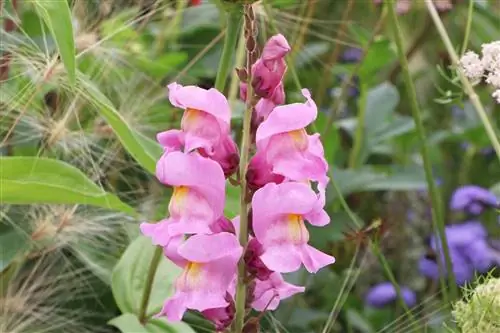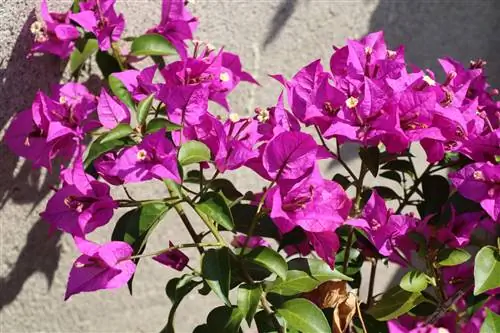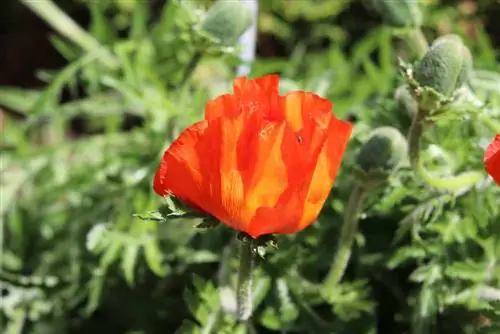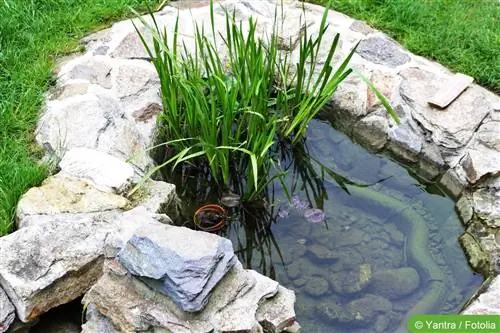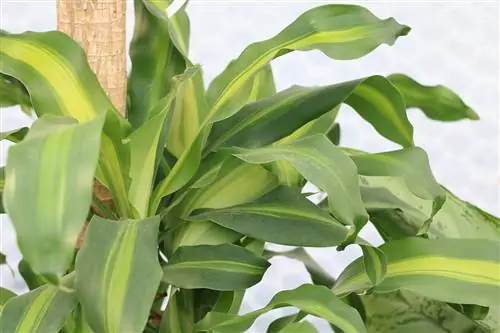- Author admin [email protected].
- Public 2023-12-17 03:39.
- Last modified 2025-01-24 12:45.
The plants are very popular with hobby gardeners because they are very robust, place few demands on the environment and often bloom with their colorful flowers well into December.
Best location
Snapdragons need sunny and warm locations. The soil should be slightly permeable to avoid waterlogging. It should ideally consist of sand, clay, gravel or humus. Rhododendron soil has also proven to be a very good soil.
- The plant also thrives in partially shaded places.
- However, if the solar radiation is too low, flowering will not occur and growth will be inhibited.
- The location should be protected from the wind, otherwise the delicate plants with their thin stems run the risk of snapping over in strong gusts of wind.
Watering snapdragons
The plant requires moderately moistened soil. The watering intervals depend crucially on the special features of the location and the exact nature of the soil. When watering, the following maxim applies: It's better to water a little too little than too much. It should be noted that the soil dries faster in sunny locations and therefore needs to be watered more frequently. The water should not be too hard. Water from the tap is often not ideal.
- Avoid waterlogging at all costs! Snapdragons are susceptible to root rot.
- Stale rainwater is ideal for irrigation water.
Sowing snapdragons
The seeds are solely responsible for the reproduction of plants. Snapdragon seeds are obtained by drying them after flowering. If the weather is favorable, sowing can be done outdoors from April. A sunny location with good soil conditions should be chosen. Since there can be another frost at night in April, the chance of germination is increased if the plants are grown indoors. Growing plants can begin in your own four walls from January.
Important: Snapdragons are cold germinators, which means the seeds and soil must be placed in the refrigerator a few weeks before sowing! This simulates a cold period. When sowing the seeds should be carefully pressed into the soil and only lightly covered with a little soil. Humus-rich potting soil is ideal for forming a root ball. The soil should be kept moderately moist until germination. It is advisable to use a foil. The tender plants should definitely be pricked out when they are a few centimeters tall and after pricking out the young plants should be planted at a minimum distance of 6 to 8 cm.
- The germination period is between 6 and 21 days.
- The plant can be cultivated in clay pots.
- The shoot tips should be shortened again and again. This enables particularly beautiful growth.
- In the home garden, the plants sow themselves.
Cutting and fertilizing plants
The shoot tips of the young plants are shortened slightly. This gives the plant a bushy growth. Wilted flowers should be removed quickly.
Snapdragons are very robust and, in the right location, can do without fertilizers. However, if the soil is poor in nutrients, the hobby gardener should resort to some support in the form of organic fertilizer.
- Mix compost soil into the substrate as fertilizer.
- Pond water can also be used for additional humidification.
- Fertilizers from the hardware store must be lime-free!
Overwintering snapdragons
Snapdragons are not hardy enough to survive the cold season in Germany. However, if the winter is particularly mild and temperatures do not reach below -10 °C, then there is a good chance that the plant will make it.
- Seeds sown in the ground can survive sub-zero temperatures. As soon as it gets warm again in spring, these begin to germinate.
- In the short term, the plant can also survive temperatures down to -10 °C.
- However, if the cold period lasts longer, then the plant is lost.
Diseases and pests
Snapdragons can be attacked by various diseases and pests. Many of these unwanted appearances can be prevented through careful care. In the case of other diseases, the right measures must be taken so that the plants can recover. Root rot is most often due to overwatering. The persistent waterlogging causes the leaves to gradually fade and in the end the entire plant dies. If there are signs of root rot, further watering should be avoided. If possible, moist soil should be replaced with dry soil. Aphids are not exactly picky and also like to attack snapdragons. Aphids reproduce particularly well in monocultures. Therefore, severe aphid infestations can be prevented by growing mixed crops. Fungus gnats prefer to lay their eggs in moist soil. The mosquito larvae eat the roots of the host plant, here the snapdragon.
- Natural enemies such as ladybirds, lacewing larvae and gall midges love to eat aphids.
- Using quartz sand makes it more difficult for fungus gnats to lay eggs.
- Do not spray the plants with the garden hose!
What you should know about snapdragons in brief
Snapdragons are robust ornamental plants that can be found in many gardens thanks to their colorful flowers. If you choose the right location and provide the right care, the plants can delight you well into December. By sowing the plant independently, the hobby gardener only has to worry about a sufficient water supply. Overwintering in the home garden is only possible in particularly mild winters. Because of their bright colors, snapdragons are also popular as balcony plants.
- The snapdragons include around 20 to 40 species. They belong to the plantain family. They used to be classified as part of the figwort family.
- The snapdragons are most species-rich in the western Mediterranean region. The most famous ornamental plant of this genus is the large snapdragon.
- The cultivated forms of the large snapdragon are widespread ornamental plants. The plant species originally comes from South Africa. There are also wild forms.
- The large snapdragon has a zygomorphic flower shape that shines in white and yellowish and red tones and is considered undemanding.
- The lower lip of the flower is everted to form a palate. This closes the so-called corolla tube. The flowers are 3 cm to 4 cm long.
- The plant is partially hardy and is mostly used as an annual plant.
- The large snapdragon is a herbaceous plant that is considered very resilient. Dryness, cold and rain do not affect the snapdragon.
- When sowing the seeds are covered thinly with soil. Sowing outdoors is possible from April.
- Sowing in so-called sowing containers is possible - depending on the mixture - from January or February up to and including April.
- If you have decided to sow the seeds in sowing containers, you can plant them in the garden or on the balcony when the seedlings are strong enough.
- If seed formation is to be prevented, the snapdragon must be cut lengthwise.
There are other species besides the large snapdragon. Tall varieties are usually not particularly stable and it is recommended to fix them with wooden or bamboo sticks. Snapdragons typically bloom between July and October. The height of the plant, which can also be used as a cut flower, is between approx. 60 cm and 70 cm, depending on the mixture. Snapdragons are ideal as a butterfly meadow.

